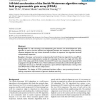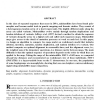27 search results - page 5 / 6 » Evolutionary Two-Dimensional DNA Sequence Alignment |
BMCBI
2007
13 years 10 months ago
2007
Background: To infer homology and subsequently gene function, the Smith-Waterman (SW) algorithm is used to find the optimal local alignment between two sequences. When searching s...
BMCBI
2011
13 years 1 months ago
2011
Background: Next-generation sequencing (NGS) offers a unique opportunity for high-throughput genomics and has potential to replace Sanger sequencing in many fields, including de-n...
ICPP
2009
IEEE
14 years 4 months ago
2009
IEEE
—Recent advances in DNA sequencing techniques have led to an unprecedented accumulation and availability of molecular sequence data that needs to be analyzed. This data explosion...
RECOMB
2002
Springer
14 years 10 months ago
2002
Springer
In the class of repeated sequences that occur in DNA, minisatellites have been found polymorphic and became useful tools in genetic mapping and forensic studies. They consist of a...
BMCBI
2006
13 years 9 months ago
2006
Background: The discovery of cis-regulatory motifs still remains a challenging task even though the number of sequenced genomes is constantly growing. Computational analyses using...


